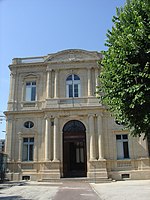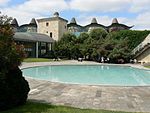Bordeaux ( bor-DOH, French: [bɔʁdo] (listen); Gascon Occitan: Bordèu [buɾˈðɛw]; Basque: Bordele) is a city on the river Garonne in the Gironde department, Southwestern France. A port city, it is the capital of the Nouvelle-Aquitaine region, as well as the prefecture of the Gironde department. Its inhabitants are called "Bordelais" (masculine) or "Bordelaises" (feminine). The term "Bordelais" may also refer to the city and its surrounding region.
The city of Bordeaux proper had a population of 259,809 in 2020 within its small municipal territory of 49 km2 (19 sq mi), but together with its suburbs and exurbs the Bordeaux metropolitan area had a population of 1,376,375 that same year (Jan. 2020 census), the sixth-most populated in France after Paris, Lyon, Marseille, Lille, and Toulouse.
Bordeaux and 27 suburban municipalities form the Bordeaux Metropolis, an indirectly elected metropolitan authority now in charge of wider metropolitan issues. The Bordeaux Metropolis, with a population of 819,604 at the Jan. 2020 census, is the fifth most populated metropolitan council in France after those of Paris, Marseille, Lyon and Lille.
Bordeaux is a world capital of wine: many castles and vineyards stand on the hillsides of the Gironde, and the city is home to the world's main wine fair, Vinexpo. Bordeaux is also one of the centers of gastronomy and business tourism for the organization of international congresses. It is a central and strategic hub for the aeronautics, military and space sector, home to international companies such as Dassault Aviation, Ariane Group, Safran and Thalès. The link with aviation dates back to 1910, the year the first airplane flew over the city. A crossroads of knowledge through university research, it is home to one of the only two megajoule lasers in the world, as well as a university population of more than 130,000 students within the Bordeaux Metropolis.Bordeaux is an international tourist destination for its architectural and cultural heritage with more than 350 historic monuments, making it, after Paris, the city with the most listed or registered monuments in France. The "Pearl of Aquitaine" has been voted European Destination of the year in a 2015 online poll. The metropolis has also received awards and rankings by international organizations such as in 1957, Bordeaux was awarded the Europe Prize for its efforts in transmitting the European ideal. In June 2007, the Port of the Moon in historic Bordeaux was inscribed on the UNESCO World Heritage List, for its outstanding architecture and urban ensemble and in recognition of Bordeaux's international importance over the last 2000 years. Bordeaux is also ranked as a Sufficiency city by the Globalization and World Cities Research Network.










